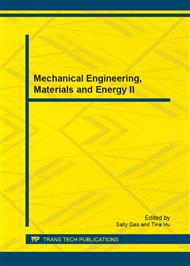[1]
Haolei Guo, and Yu Pan: Journal of Environmental Engineering, Vol. 28 (2010), pp.459-462 In Chinese.
Google Scholar
[2]
Ministry of Environmental Protection of People's republic of China. Standard for Pollution Control on the Landfill Site of Municipal Solid(GB 16889-2008), Beijing (2008), in press. In Chinese.
Google Scholar
[3]
Ministry of Environmental Protection of People's republic of China. Standard for Pollution Control on the Landfill Site of Municipal Solid (GB 16889-1997), Beijing (1997), in press. In Chinese.
Google Scholar
[4]
Ministry of Housing and Urban-Rural Development of the People's Republic of China. Technical code for municipal solid waste sanitary landfill (CJJ17-2004), Beijing (2004 ), in press. In Chinese.
Google Scholar
[5]
Ministry of Housing and Urban-Rural Development of the People's Republic of China. Technical code for liner system of municipal solid waste landfill (CJJ113-2007)[S], Beijing (2007) , in press. In Chinese.
Google Scholar
[6]
Yangsheng Liu, and Qingzhong Bai: Journal of basic science and engineering, Vol. 10 (2002), P. 143-149 In Chinese.
Google Scholar
[7]
Lo I M C, Mak Raynod: Wat. Sci. Tech., Vol. 38 (1998), pp.143-150.
Google Scholar
[8]
Rene M.C. Lo, Raymond K.M. Mak, and Samuel C.H. Lee: Journal of Environmental Engineering, Vol. 123 (1997), pp.25-32.
Google Scholar
[9]
Jams A. Smith, and Peter R. Jaffe: Journal of Environmental Engineering, Vol. 120 (1994).
Google Scholar
[10]
The Editorial Board of the handbook of the engineering geology. Handbook of the engineering geology. 4th edition, edtied by China Architecture & Building Publications, Beijing (2007), in Press. In Chinese.
Google Scholar
[11]
The Ministry of Water Resources of the People's Republic of China. Standard for soil test Method (GB/T 50123-1999),Beijing (1999), in Press. In Chinese.
Google Scholar
[12]
Hui Wang, Zurun Yue, and Chaoliang Ye: Journal of Shijiazhuang Railway Institute (Natural Science), Vol. 22 (2009), p.20 In Chinese.
Google Scholar
[13]
Zhengzhong Zeng, Lihe Ma, and Nan Zhongren: Environmental Engineering. Vol. 04 (2009), p.31 In Chinese.
Google Scholar
[14]
Shisheng Wu, Jingliang Dai, and Peng Bo: Journal of Xi'an Highway University. Vol. 18 (1998), p.17 In Chinese.
Google Scholar
[15]
Xian Qu, Pingjing He, and Shao Liming: Environmental Engineering. Vol. 2 (2005),p.82 In Chinese.
Google Scholar


